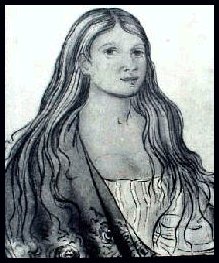Laws of the Cherokee Nation: Adopted by the Council at Various
Periods.
Cherokee
Advocate Office:Tahlequah, Cherokee Nation, 1852. This
source contains the Cherokee Constitution(s) and the laws passed at
Tahlequah through 1851. The first Cherokee Constitution of
1827 stripped women of their voting rights on the Council, adopted some
of the American's view on proper conduct for women, but allowed women
to maintain their property rights. This collection also contains laws
and amendments for all Cherokee in the Cherokee Nation. This was
an interesting source because so many of the laws and the Constitution
are sited in other sources and it was intriguing to see the original
source.
Owen, Narcissa. The Memoirs of Narcissa
Owen 1831- 1907. Center for American History,
University of Texas
at Austin.
This was a useful and interesting account because it is so difficult to
find primary sources. It offers a unique perspective to
hear a personal account from a Cherokee woman who was alive
during the Removal, and lived at one of the Missions Boarding
Schools. Mrs. Owen tells about some of the Cherokee legends and
the history of the seven clans of the Cherokee. She also writes
about her father's relationship with President Thomas Jefferson
which is interesting as well. This book provides a personal
perspective of what life would have been like at that time growing up
as a Cherokee woman. This book provides some Historical
information and I found it useful for background information; however,
it did not provide a lot of pertinent research data for my specific
topic.
Petitions of the [Cherokee]
Women's Councils, 1817, 1818. American
History Center,
University
of Texas at Austin.
The petitions are addressed to the Cherokee National
Council and the women read them directly to the Council. The
first one in 1817, the second in 1818. The petitions both beg the
council not to cede anymore of their lands to the United States.
They refer to the Council as "Our beloved Children" They argued
that it would be impossible to move us all and to hold firm against the
white man because their land was given to them by the Creator.
These petitions were useful to read because you get to see a firsthand
account of the women's feelings and how they interacted with the
Council.
Ross, John. The Papers of John Ross Volume
I. 1807 - 1839. Edited by Gary E. Moulton
University of Oklahoma Press: Norman 1985.
Reading through Chief Ross's correspondence provided useful research,
but was heartbreaking at times. It gives the reader a much more
personal connection to Chief Ross and his tribe when you read the
countless number of letters spanning through decades. It shows
the Cherokee struggle to merely exist through constant
railroading from the U.S. Government. The responses from
the various Government officials, including President Andrew Jackson,
were enlightening as well. The correspondence definitely gives
the reader a personal view of all the changes that the Cherokee made
trying to appease the U.S. Government in order to hold onto their land
and their culture.
United States. 22nd Congress 1st Session DocumentNo.
45. Memorial
of a Delegation of the
Cherokee Tribe of Indians. American
History Center, University of Texas at Austin.
This is a well written speech asking Congress to please intercede and
protect the Cherokee Nation from the constant invasion and harassment
from the Georgia State Government. The State of Georgia
fails to comply with the Supreme Court rulings and continues to occupy
Cherokee land and impose their State Laws on the Cherokee Nation.
This address is their plea to Congress to intervene after numerous
attempts to call on the President have been repeatedly ignored.
This is a short but useful document for the purpose of seeing in
writing what the Cherokee leaders perspectives were. This speech
does not discuss the upheaval to the gender balance caused by the
offenses of the State of Georgia, but again, it helps to identify the
lengths the Cherokee went to to try and save their land and culture.
Seondary Sources:
Johnston, Carolyn Ross.
Cherokee Women in
Crisis: Trail of Tears, Civil War and Allotment
1838 - 1907. Tuscaloosa,
Alabama: The University of Alabama Press, 2003.
This was a very informative book that gave an easy to follow overview
of the change in the Cherokee woman's role after the introduction and
eventual intrusion of the white man's culture on to the
Cherokee. I found this to be a very enjoyable book to
read. It gives several examples and explanation of the events
that ultimately confused the gender balance. This book also
outlines how these changes caused further strife and hardship to a
Culture already fighting to survive. This book was very easy to
read and it makes you want to learn more on the topic.
Shoemaker, Nancy. Negotiators of
Change: Historical Perspectives on Native America Women.
New York, New
York: Routledge, 1995.
This book tells the history of several different tribes of
American Indians through the eyes of Indian women. This
book covers a period from the 1600's to the 1900's and is very useful
in seeing how different women's lives were from men's. There is a
good portion on Cherokee women and their response to the U.S.
Government's demand to "civilize" them while taking their land.
This book was extremely useful in that respect and would be a good tool
for anyone studying Indian Women in general.
Perdue, Theda. Sifters: Native American
Women's Lives. Oxford, New York: Oxford
University
Press, 2001.
This book was a collection of biographies of exceptional Native
American Women from several different tribes. The only Cherokee
discussed in this book was Catharine Brown who is one of the most
famous Cherokee converts to Christianity. Catharine has been
portrayed by historians as the most successful conversion to
Christianity and "civilization". While several of these
stories were entertaining and interesting stories about some very
courageous women, the stories were not useful for the topic
of this paper. This book would provide useful information
about the differences among women in different tribes .
Perdue, Thedaand Michael D. Green. The Cherokee Removal: A
Brief History with Documents. 2nd
ed. Boston: Bedford, 2005.
Theda Perdue has written a number of great books on the Cherokee
culture and Cherokee women specifically. This was a great tool
for understanding the cultural changes that effected and even disrupted
the gender balance between Cherokee men and women and the individual
struggles as well as communal divisions that occured in the period
leading up to and through the Removal Policy.
Perdue, Theda. Slavery and the Evolution
of Cherokee Society 1540 - 1866. Knoxville, Tennessee:
University of Tennessee Press, 1979.
This book tells about the effect that slavery had on Cherokee
Society. It provides insight into another social adaptation that
the Cherokee were faced with which caused a change in their
culture. This was mildly useful for my research paper. Only
the wealthy, more acculturated or assimilated Cherokee women owned
slaves. This did act to further divide the nation between
traditionalists and acculturated Cherokee. This also
further domesticated and changed the role of the Cherokee woman
because with slaves, almost all of the work was done and the
woman did not have any job to prove her worth in society.
Hungry Wolf, Beverly. The Ways of My Grandmother.
New York, New York: William Morrow and
Company, Inc.,
1980.
This book is a recollection of the many lessons Ms. Wolf's
Indian Grandmother taught her. This book is an important part of
preserving a culture that has faded away. Beverly Wolf imparts
many of the legends and traditions that were passed down from mother to
daughter for generations as well as methods for cooking, methods of
treating common ailments, to their general way of life. This is
an informative book on Native American women's culture, but was not
useful for this research topic. This book does not discuss any of
the changes in gender role due to the European/American influence.
Bataille
, Gretchen M. and Sands, Kathleen Mullen. American Indian Women.
Lincoln, Nebraska: The
University of Nebraska Press, 1984.
American Indian Women discusses the
misconceptions the white man when had when he evaluated the Indian
culture and how women have been portrayed throughout history that women
were "submissive, and beasts of burden" based on the work they saw
women doing in the fields. This book aims to dispel that myth and
enlighten people to see that the women never saw themselves that way in
these cultures. Rather, they saw themselves as equal members of
their society. This book also contains some biographies of
exceptional Indian women and is a very informative book on the Indian
woman's role within a tribe. This book does not go into great
detail about the Cherokee specifically, but provided some very valuable
information on the Indian Woman in general and her gender role.
Interesting Web
sites:
The Museum of the Cherokee Indian in Cherokee, Carolina. Cherokee Museum
Official Site of The Cherokee Nation in Tahlequah, Oklahoma.
Cherokee Nation Web site
Pathfinder created by
Maryleigh Hutcheson


